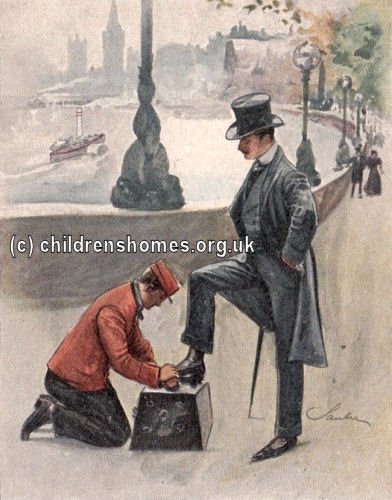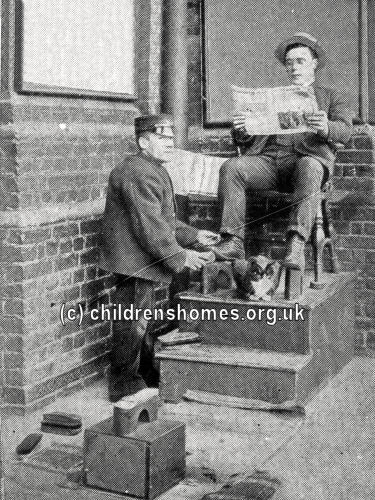Shoeblack Brigades
The idea for London's first Shoeblack Brigade was born on 28 November 1850, following a meeting of Ragged School teachers. They were considering potential ways in which boys might be able to gain new employment when the Great Exhibition took place the following summer. After the meeting, three of the attendees, RJ Shape, John MacGregor and JR Fowler, were walking along Holborn together when one of them made the suggestion that some of the boys work as shoeblacks, cleaning the shoes and boots of foreign visitors, as happened in Paris. The three pledged money for the idea and began to promote the scheme, raise funds and form a Committee. At a public meeting on 19 January 1851 at the Field Lane Ragged School, a demonstration was given by the first recruit to the Shoeblack Brigade. A young man, a former expert thief, mounted the platform in his uniform of a bright red jersey and black apron, and equipped with a blacking-box, foot-stand and brushes, showed how the work would be done. The Honorary Secretary said the arrangement envisaged locating a number of boys at various points on metropolitan thoroughfares, to provide to visitors, throughout the summer, clean shoes, with civility and at a standard charge of one penny. It was reported that several kind ladies had provided thirty uniforms, ten boxes, and five sets of brushes, and that an inspector would shortly be appointed. On 24 February, a training base was set up in some rented rooms near John Street, in the Strand. At the end of March, five boys began work, the first in a corner of Leicester Square. An observer of the occasion recorded that:
Pitches were allocated to the boys by the police, with the Brigade operating along the Strand, Piccadilly, Regent Street, Holborn, and at the Parks. Because some locations were more lucrative than others, the allocation of pitches was changed twice a week.
During the Great Exhibition, an average of 25 boys were employed and cleaned 101,000 pairs of shoes, producing an income of more than £500. After the Exhibition closed in October, five of the boys emigrated to America.

A London Shoeblack, c.1880s. © Peter Higginbotham
Following the example of what became known as the Central or 'Reds' Shoeblack Brigade, the movement gradually spread across the whole of London, with around a dozen Brigades eventually being formed, each with its own distinctive uniform. Some Brigades made a point of including boys with various forms of physical disability such as the deaf and dumb and the physically disabled — what were then usually referred to as 'cripples'. In most cases, the Brigades also provided hostel-style accommodation for their members. Over the years, these homes sometimes changed their location so have different addresses at different dates as indicated in the table below.
| Brigade | Founded | Address(es) | Places | Uniform | Notes |
|---|---|---|---|---|---|
| Ragged School / Central (Reds) Shoeblack Society | 1851 | Ship Yard. 12 Mac's Place, Greystoke Place, Fetter Lane. 2 Saffron Hill (became 28 Great Saffron Hill, early 1900s) | 45 | Red jacket | |
| Columbia Messenger and Shoeblack Brigade | 1869 | 11 Wood Street, Spitalfields | 24 | ||
| East London (Blue) Shoeblack Society | 1854 | 96 Mansell Street, Whitechapel (in 1884) | 80 | Blue guernsey | Also included cripples, deaf and dumb. |
| 86 Leman Street, Whitechapel (by 1890) | 80 | ||||
| Islington and North London Shoeblack Brigade | 1858 | 30 York Road, King's Cross (in 1890) | 50 | Brown guernsey | Also included cripples. |
| 146B King's Cross Road (by 1895) | 29 | ||||
| North-West London Shoeblack Brigade and Ragged School | 1857 | 33 (or 33A) John Street West (in 1882) | 45 | Red with black facings; check cap (later black with red band). | Also included cripples, deaf and dumb. |
| 241 Marylebone Road (by 1884) | |||||
| Notting Hill Shoeblack Brigade | 1869 | Shaftesbury Hall, Prince's Road | 75 | Blue | |
| St Vincent de Paul Shoeblack Brigade (RC) | 1857 | Newton Street, Holborn | No Home? | Blue with red cuffs. | |
| 31 Queen Square, WC (by 1884) | |||||
| South London Shoeblack Society | 1854 | 223 Borough High Street, Southwark (in 1884) | No home? | Red guernsey with black collar | Also included cripples, deaf and dumb. |
| 15 Bath Terrace, Union Road, Borough (by 1890) | 35 | ||||
| Tower Hamlets Mission Shoeblack Brigade | 1873 | 23 Stepney Green (in 1879) | 35 | Red guernsey with dark blue facings. | |
| 23A Tollett Street, Mile End (in 1884) | 35 | ||||
| Union Jack Shoeblack Brigade | 1868 | 8 Three Colt Street, Limehouse | 20 | Blue with white facings | Affiliated with Barnardo's from 1875. |
| West London Shoeblack Society | 1857 | 57 Bessborough Place, Pimlico (in 1895) | 53 | Purple; later Blue with red facings | |
| Earl Street, Westminster (by 1897) | 40 |
In the Central and most other Brigades, the boys' earnings were paid into the home each day with a third of the money paying for their keep, a third being placed into their individual bank savings accounts, and a third given back to them. To encourage honesty and application, prizes ranging from 3s.6d. down to 6d. were awarded each month. The West London Brigade adopted an alternative system where the boys paid 1s. 6d. a week for lodging, and for their board according to what they consumed. They also paid from 4d. to 1s. 8d. a day for their pitches, according to the location.

London Shoeblack, c.1902. © Peter Higginbotham
The Shoeblack Brigades had largely disappeared by the onset of the First World War. Shoe-shining continued as a London street trade for many years, however, although by the 1960s it had virtually vanished.

London Shoeblack, early 1900s. © Peter Higginbotham
Boys' Shoeblack Brigades were also started in a few other cities such as Leeds (1869), Manchester (1871) and Dublin (1879).
Bibliography
- Banks, Elizabeth L Campaigns of Curiosity: Journalistic Adventures of an Americam Girl in London (1894, F Tennyson Neely)
Links
- None identified at present.
Except where indicated, this page () © Peter Higginbotham. Contents may not be reproduced without permission.


